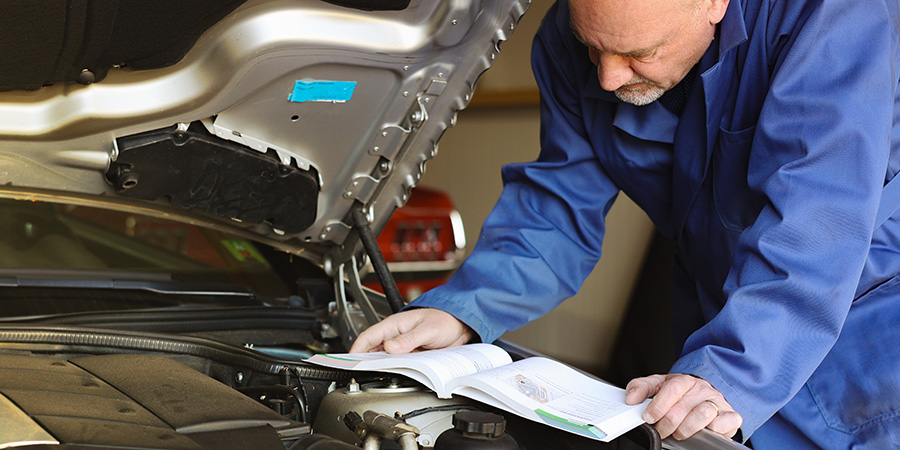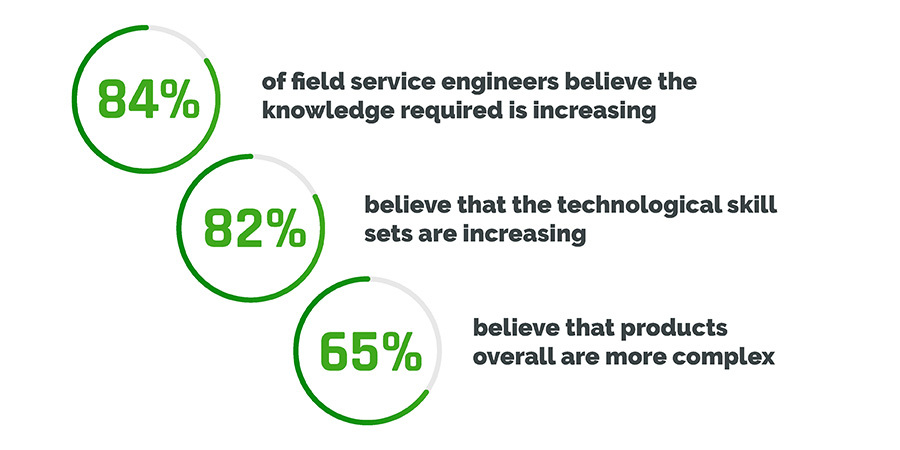Why Do You Need Augmented Reality in the Service Industry?
Challenges around workforce efficiency, increasing product complexity, and high customer expectations are nothing new in the service industry. For automakers, these challenges create unique and acute pain points. Cars continue to become more complex, with increasing variety and customization. The rise of electric vehicles represents a major fork requiring entirely different service skill sets and expertise. To meet these demands, technicians require access to better training and on-the-job resources so they can provide efficient, quality service. And frankly, the printed service manuals and guides of the past simply can’t keep pace with innovation or the globally dispersed nature of service organizations.
Automakers are rising to meet these challenges with augmented reality (AR), which helps leading automotive service organizations upskill and reskill their service technicians, empower their workforce, and improve the service experience for customers. In many ways, AR represents the natural next step in digital transformation for manufacturing and service teams. While industrial companies across all sectors have spent the past decades investing heavily in factory and service technology, AR represents an opportunity to up-level the human component of their business.
Service Council’s CEO John Carroll recently joined PTC’s General Manager of Vuforia, JJ Lechleiter, to discuss the data behind current workforce challenges and the role of AR. Their conversation provides a revealing look at how the automotive industry is poised to capture unique benefits from AR technology.
What are the service challenges in manufacturing?
As products become more complex, experts retire, and customers expect more and more from the service experience, the spotlight is on the workforce to stay productive and engaged. But research shows that traditional work instructions aren’t giving service technicians the knowledge and support they need to do their jobs well.
Decreasing engagement and an aging workforce
According to results from Service Council’s 2022 Voice of the Field Service Engineer survey, service industries are seeing a lack of engagement among younger technicians. Considering the growing retirement crisis on top of that, service leaders are facing a workforce crunch that is making it harder than ever to meet the needs of their business, deliver quality service, and maintain customer relationships through these workforce challenges.

Product complexity
Decreased engagement in the workforce and pressure from leadership to improve performance is complicated by increasing product complexity—and research results show that technicians agree. According to the Service Council, “84% of field service engineers believe the knowledge required is increasing; 82% believe that the technological skill sets are increasing; and 65% believe that products overall are more complex.” So not only are manufacturers looking at a drain of skilled workers, but the workload demands are getting harder at the same time.

Source: Service Council
What are the service challenges in the automotive industry?
Service leaders in the automotive industry are seeing these challenges amplified by the increasing popularity of electric vehicles, which further complicates service while customers demand improvements in efficiency and quality.
Traditional vs. electric vehicles
EV versus gas isn’t just a big difference for car owners; these are completely different types of vehicles with distinct automotive service requirements. Traditional vehicles require more service the longer they’re on the road, driving up wait times. Meanwhile, electric vehicles demand an entirely different service skill set, and technicians are seeing more and more of them—according to the Service Council, the 14% of registered electric vehicles in 2022 has risen to 19% in 2023.
Automotive service technicians feel pressure to be proactive
As vehicles become more complex, so does automotive service. Technicians face more pressure than ever before as they must be knowledgeable, skilled, and proactive with problem solving to avoid long wait times. This challenge is amplified by the fact that service technicians already find it difficult to stay engaged with their work.
Customers expect an enhanced service experience
In the age of delivery trackers and other day-to-day consumer experiences, customers have come to expect the same speed and enhanced service options for their vehicles. And in fact, positive customer service has become a competitive advantage for companies that can execute. But those high expectations have backed the service industry in a corner, as they put increasing demands on a dwindling, disengaged workforce. Given these challenges, automakers embracing AR to pioneer upskilling and reskilling solutions isn’t surprising; rather it’s one of their few lifelines to keep pace with product complexity, customer expectations, and their workforce skills crisis.
What are the benefits of augmented reality in the service industry?
In addition to the unique challenges of automotive service, Carroll and Lechleiter discussed how augmented reality has proven benefits in the automotive service industry—whether the technology is helping leaders empower their workforce, improve the customer experience, or reduce costs.
Empowering service technicians
In their conversation, Carroll and Lechleiter described AR as a “technician-agnostic platform.” That’s because AR is a valuable tool for technicians at any age and experience level, which includes a variety of learning styles and needs. According to Service Council research, 80% of service leaders implementing visual support technology like AR report that it has “very positively” or “somewhat positively” improved problem resolution times.
With AR, the valuable knowledge held by seasoned experts can be shared across the service organization. Those SMEs are using AR to create helpful content for training and on-the-job guidance, which can then be shared and scaled across the organization. And that guidance provides critical support when the SME isn’t present, and even after they’ve retired. By supporting knowledge transfer and integrating processes, AR helps automotive service organizations optimize their experts’ time.
Improving the customer experience
AR delivers the enhanced service experience customers are looking for, and the increasing technology investments among service leaders prove that there’s a continued desire to improve. According to Carroll, 67% of respondents told the Service Council they’d be increasing their technology investments in 2023. Investments include knowledge management, business intelligence, machine learning, the Internet of Things (IoT), field service management systems, and service lifecycle management.
Retiring workforce
While nothing will prevent seasoned service experts from retiring and aging out of the workforce, AR is helping capture, share, and scale their knowledge before it leaves the business. And before those experts retire, they can maximize their valuable time doing their own work rather than helping newer technicians complete tasks.
Reduced training costs
AR delivers more engaging and immersive training experiences than traditional classroom learning, at a lower cost. AR training can be particularly helpful for visual learners and digital natives—the new generation of workers who grew up around technology. In fact, the availability of these tools can represent a competitive advantage for service organizations looking to attract talent in a tight market.
Remote troubleshooting
AR also improves knowledge transfer through remote troubleshooting. Should service technicians in the field require assistance with a repair, the technology can connect them with remote experts for real-time problem solving and visual guidance, improving on-the-job safety and reducing truck rolls.
Connecting AR and the digital thread
Digital thread opportunities were another key focus area for Carroll and Lechleiter as they discussed scaling augmented reality in the service industry. By connecting AR with other systems and solutions—like collecting 3D product data from product lifecycle management (PLM)—service leaders unlock “design for serviceability,” enable continuous process improvements, and enhance collaboration across the organization through the asset lifecycle.
Get data-backed recommendations for service leaders
Augmented reality has proven benefits in the automotive service industry—from improving workforce engagement and knowledge transfer to creating a more streamlined experience for customers—and Service Council’s research shows a growing need for the technology in the age of electric vehicles.
As service leaders expand their investments in AR and other technologies, Carroll offers a few words of advice. First and foremost, digital transformation should focus on workforce empowerment. Importantly, the entire workforce—from service technicians to business leaders—should be involved in the decision to implement AR. It’s not just a matter of getting buy-in from financial decision makers, but also those members of the workforce who will use AR in their day-to-day jobs. Involving them early in the process helps them understand that they're not just being handed a new directive, but they’re integral to the company’s digital transformation. And finally, implementing AR should be considered as an opportunity to upskill and reskill the entire workforce—from new technicians who might be struggling with on-the-job engagement to seasoned experts who are nearing retirement.
Is your organization seeking opportunities to improve workforce engagement, address unique automotive service challenges, and meet rising customer expectations? Augmented reality is proving to be a valuable tool for training, upskilling, reskilling, knowledge transfer, and more. To get additional insights from Carroll and Lechleiter—including Service Council research results and more—watch their full conversation on Analyst Insights, “How Augmented Reality Improves Automotive Customer Service.”